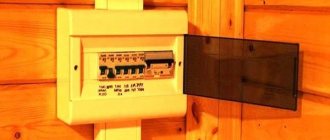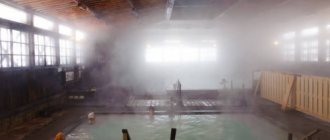Everyone who builds their own bathhouse faces the question of how to heat the water? Of course, you don’t have to worry about this question by simply placing a barrel of water in the steam room. The bathhouse is heated - the water is heated. This is what our ancestors did. In winter, the barrel was filled with snow and then washed with melted water.
But progress is moving forward, and modern snow in the vicinity of megacities is not worth washing your face with, the environment is not what it is now. Unless in the remote Siberian taiga you can still collect pure snow.
What options can be offered to the developer now, how to make the process of washing in a bathhouse comfortable and convenient? This will be discussed in the article.
Remote water tank
A very convenient option to use. Makes it possible to heat water and at the same time use it to heat another room (washing room). With it, you won’t get a situation where the water boils and creates unnecessary wet steam in an unheated steam room. This is the optimal solution for a Finnish sauna with dry steam.
Remote tank, connection
The remote design is connected to a furnace with a heat exchanger (water is heated due to circulation), which makes it possible not to tie it to a specific place, but to install it where it is more convenient. The heat exchanger can be either built into the stove or on the chimney pipe. The volume of the heat exchanger on the pipe is recommended to be at least 15 liters.
Device Features
At the exit of combustion products, the temperature reaches higher values. The water here is heated quickly from a metal chimney, without the use of additional heat sources. The heating rate is explained by the high thermal conductivity of the metal and the large heat transfer area.
Since the tank is located in the upper part of the room and directly above the stove itself, the boiling water does not cool down for a long time .
Advantages
Main advantages of the design:
- Economical - water is heated during the heating of the room, using the maximum heating zone of the stove.
- Efficiency – water is heated in the shortest possible time and the temperature is maintained for a long time.
- Convenience - the tank on the pipe does not eat up the space of the bathhouse, which is especially important for small rooms.
- Ergonomics - the tank capacity on the pipe can be significant, but its heating time will be short. The design is such that by increasing the volume of the container along the length of the pipe, the heating area of the water simultaneously increases.
- The service life of the chimney increases, since water prevents it from burning out.
We recommend that you read: Sewerage pipeline made of polyethylene pipes
Flaws
Difficulty controlling the water level during the heating process; inconvenience caused by the need to add water when the stove is hot. These disadvantages are inherent in the simple design of the tank in the absence of communications, through which it is much easier to regulate the amount of water.
Installing a tank on a large-volume pipe presents certain difficulties. This design with water exceeds the 100 kg mark, which requires special fastenings.
The main disadvantage is the inability to obtain dry steam; the water in the tank on the pipe will boil, creating additional humidity in the room.
Mounted water tank
Mounted tank "Ermak Elite 16S"
It can be quickly mounted/dismantled, which is its main advantage. It is usually attached to one of the walls of the stove using loops and hooks. Accordingly, heating occurs from the furnace itself. The disadvantage of this design is that it is unsafe (you can get burned), and the water boils early, filling the steam room with wet steam. With the help of a connected circuit, the hanging structure can be made more convenient - a remote option.
Mounted water tank, mounting methods
Which fuel is better to choose?
Specifically for baths, as many as six types of boilers are produced today:
- solid fuel;
- on gas;
- on diesel fuel;
- electrical;
- steam boiler for a bath;
- combined.
And each of these types has its own advantages and disadvantages. A photo will help you look at such boilers for a bath in more detail, and here is this video:
Solid fuel: cheap but cheerful
If you buy a coal boiler for a bathhouse, then you will need to look for coal of a strictly defined moisture content and fraction. And it will be difficult to get rid of slag, dust and buckets in the bathhouse.
But, at the same time, solid fuel boilers for a bathhouse are capable of storing heat in it for a long time, but are not at all designed for automatic operation. In addition, they require periodic cleaning - not the most pleasant job.
By the way, according to reviews from experienced bathhouse attendants, the KS-TGZh-25A is recognized as the best solid fuel boiler among existing industrial ones, which has the deepest firebox found in domestic boilers. Its main advantages are that such a unit can be heated with both coal and wood. In addition, such a boiler has a special flange welded to the bottom for the burner. This means that it will be possible to install a gas or diesel burner instead of a pellet burner, or diesel fuel, if the steam room and washing bath are well insulated from unpleasant odors.
Gas: clean, but problematic
A modern gas boiler for a bath has a significant advantage over other types - in that there is no ash or burnt smell near it, everything around it is always clean and tidy. In addition, such a boiler room can be fully automated, and the burners and boiler themselves are inexpensive.
In addition, gas boilers for baths are considered the most compact - their weight does not exceed 50 kg, but the power reaches up to 40 kW. Thanks to all this, such a boiler can effectively heat not only a miniature bathhouse, but a huge bathhouse complex with a swimming pool of up to 300 m2.
Electricity: only with three-phase network
An electric boiler for a bathhouse, electricity drawings provide only those where it is possible to use a night tariff, and the heat can be stored in the storage tank. The total capital costs, of course, are small - you can even independently weld a metal barrel with a heating element inside. But all this requires a three-phase network with three times more power. Otherwise, such a boiler will simply be golden at cost.
But electric boilers for baths are the cleanest in environmental terms. They do not require a ventilation system, a lot of space, or fuel. They are easy to control and can work in automatic mode as long as you like. True, they consume a lot of electricity, and therefore are considered quite an expensive pleasure.
Material
When choosing a tank, you should pay attention to the material from which it is made. Stainless steel products are in great demand, having many advantages. They are not subject to corrosion, have excellent thermal conductivity (water heats up quickly), and are resistant to sudden temperature changes (the deformation coefficient is very small).
Enameled options are good if handled carefully. Their disadvantage is possible chips that lead to corrosion. To avoid this, the tank can be treated with special heat-resistant paint (unless it will be built into the oven).
What pipes to use for water supply from a well
When organizing water supply for a cottage or bathhouse, it is important to choose the right pipes. They should be:
- Safe, especially if you use the water for drinking.
- Durable, since most of the pipeline is laid below the soil freezing level, replacement entails a large amount of work.
- They tolerated temperature changes well.
- Easy to install and repair.
Previously, only metal pipes were used. There were no other options. But, firstly, they rust quickly, and secondly, installation and replacement are only possible with a welding machine. Today there are other options.
Between the well and the house, cottage, bathhouse, pipes made of polypropylene or polyethylene are laid
Polypropylene pipes for water supply
In order for the water supply to serve for a long time and properly, the best option for a summer house and bathhouse is polypropylene pipes. They feel great at low temperatures; when connecting them, rubber or other gaskets are not used, which over time lose their elasticity and require replacement. They do not emit any harmful substances, do not rot or oxidize, are not damaged by fungi and microorganisms, and manufacturers claim a service life of about 50 years.
But. Polypropylene pipes require special equipment for welding. A special soldering iron is used to heat the pipe. When heated, it is quickly connected to an angle, tee, tap, etc.
Important: do not make any rotational movements when welding. This is especially true for reinforced pipes
After connecting, give it a couple of minutes to cool and you can continue assembling the water supply further. The device is not very expensive, and you don’t have to buy it. You can rent a soldering iron for polypropylene from almost any company that sells polypropylene pipes.
Another good thing about polypropylene pipes is that they are available for both cold and hot water. That is, the internal wiring of the water comb in the room can also be made from the same material. Another plus: a flat and smooth outer surface, which is easy to care for and does not require painting.
Polyethylene
To supply cold water (it cannot be used for hot water), HDPE pipes are often used - low-pressure polyethylene. They have practically the same characteristics as polypropylene (they are not afraid of frost, do not rot and are not susceptible to fungi, but at the same time they are environmentally friendly), but they have one big advantage: they can not only be welded, but also use detachable fittings. This is much more convenient, does not require special equipment, and repair/replacement becomes easier. Watch the video to see how to connect HDPE pipes.
But, on the other hand, detachable fittings mean there is a high probability of leaks. Therefore, they try to plan the pipeline so that all collapsible fittings are in accessible places and not underground.
Insulation and pressure compensation
When laying pipes (polyethylene or polypropylene - it doesn’t matter), it is advisable to take measures to compensate for soil pressure. If your soils are heaving, this is a must.
You need to lay the pipe (preferably with insulation, but possible without) in a corrugated hose of larger diameter. It will, firstly, serve as thermal insulation, and secondly, protect against excess pressure.
There is also Energoflex tubular insulation, using which you can solve the issue of thermal insulation in one fell swoop and protect pipes from excessive loads.
Insulation for water supply pipes "Energoflex"
Size
What is better to choose for heating water: heating a stove or using a heating element? This issue must be decided based on the expected number of people who will simultaneously steam in the bathhouse, as well as how quickly hot water will be needed for the washing room. When calculating water consumption for one person, a design with a volume of approximately 50 liters is sufficient. For a company, the minimum capacity should be no less than 70-80 liters.
Let us recall some more important points.
- Our recommendation for stainless steel thickness for the tank is 1.0mm.
- Be careful when choosing your tank design. You need to check that the number of pins is sufficient and see how things are going with the inputs.
- When installing and using, do not forget about the basic rules of operation and installation described in the manufacturer's instructions. Follow safety precautions.
A properly selected sauna stove and water tank will create a comfortable and healthy environment both in the sauna itself and in the steam room. After all, a bath should be a source of good mood, well-being and vigor
Advantages and disadvantages of samovar systems
The photo shows the structure of a samovar tank at the attic level; a cold water supply is connected to it.
A sauna tank on a pipe is called a samovar. It is an integral part of the chimney pipe elbow. Its location is very convenient, the water heating process occurs much faster and more uniformly than with other locations. The design itself is very compact.
The negative aspects of samovar systems include the fact that filling the tank with water is not very convenient. But this issue is easily resolved if the top of the tank is in the attic and a water tap is connected to it.
Important. It is very dangerous to make mistakes in designing the volume of the container, since you can end up with very frequent boiling of water.
The material for making samovar containers is usually stainless steel. The possibility of corrosion over time when using other materials is detrimental to the normal operation of the bathhouse, therefore the decision to install a stainless steel container is the right decision.
Among other things, the high thermal conductivity of stainless steel guarantees fairly rapid heating of the water in the samovar tank, and the strength of this material allows you not to be afraid of deformation of the device due to temperature changes.
Safety
Elliptical tank of samovar type, 73 liters.
Today it is quite easy to find among the mass of offers exactly the kind of water heating vessel that you need. Craftsmen, of course, make them from old barrels with their own hands. But the price of ready-made options is not so high, and the reliability of these systems and durability force many to turn to certified products.
Do not forget that the bathhouse is a place of increased danger. It is necessary to strictly observe precautions when handling hot water and fire. If you strictly follow the conditions specified in the operating instructions for the fuel tank, you can avoid unexpected burns and injuries.
Important. It must be remembered that it is strictly forbidden to fire the stove with an empty tank, since the welds may separate due to temperature. You should also not leave water in the system in winter if the bathhouse is cold, since frozen water can rupture the containers.
Volume calculation
So, we have figured out the types and features of tanks for chimneys. Finally, I will tell you how to calculate the optimal volume.
This is done extremely simply - one person requires 10 liters of water for bath procedures and 5 liters for a shower, i.e. only 15 liters. Of course, it is advisable to calculate the volume with a margin - it will be 20-25 liters per person.
As a result, if the bathhouse is designed for a family of four, a capacity of 80-100 liters is sufficient. The cost of such a stainless steel product is about 5,000 rubles.
That, in fact, is all the information regarding tanks for chimneys that I wanted to share with you.
What is the design
- The principle of operation is that from a large tank to a small one, cold water flows through the drive pipe, is heated in the small tank, which is called a heat exchanger, and returns through the outlet pipe to the main tank, already heated.
- If the drive and outlet pipes are positioned at the correct angle, then the water will successfully circulate by gravity thanks to natural physical laws. But in order to avoid the formation of air pockets in the system and ensure faster and more uniform heating of the water, the tank for the heat exchanger in the bathhouse is equipped with an electric pump for forced circulation of liquid in the system.
- The heat exchanger can be located directly next to the firebox itself, in which case it is installed at the stage of construction of the furnace inside the structure. Or it may have the so-called samovar operating principle, when a small tank is mounted around a metal chimney for a bathhouse directly next to the firebox.
- But regardless of the location of the tank, professionals prefer systems in which the liquid circulates freely, without additional pressure.
Conclusion
Our country is rich in craftsmen, but the bathhouse is considered a highly dangerous object. Based on this, we do not recommend installing homemade tanks. There are now enough certified products on the market, the price of which is quite affordable.
Serial model of a small capacity heater.
Did you like the article? Subscribe to our Yandex.Zen channel











